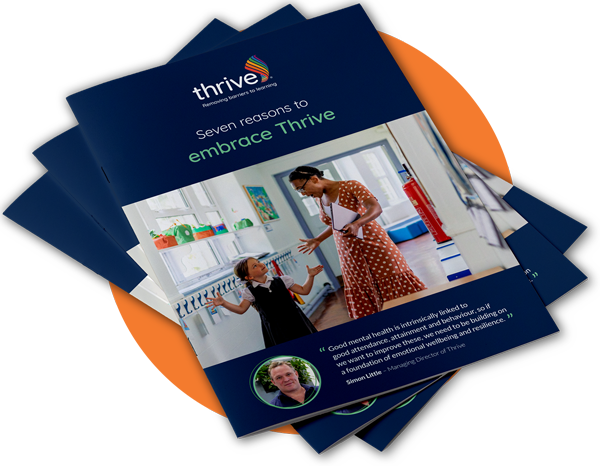Supporting mental health and behaviour in schools and academies
Thrive partners with schools to create emotionally healthy learning environments, providing staff with the tools and training to support mental health and behaviour in schools.
Through our tools and training, schools can support pupils’ social and emotional development, unlocking potential and fostering academic success.


What is Thrive in schools, and how does it work?
Thrive equips schools with the tools to build pupils' social and emotional skills.
By embedding social and emotional learning across the school, Thrive equips staff to better understand and respond to pupils' needs. Using Thrive-Online, educators assess and track emotional development and behaviour in schools, creating personalised action plans that support each pupil. This proactive, whole school approach to mental health reduces barriers to learning, and cultivates a positive environment where pupils feel safe, engaged, and ready to achieve their full potential.
Popular courses for educators
Explore our training designed to support mental health and behaviour in schools, helping to remove barriers to learning.

Childhood Thrive Licensed Practitioner
Learn to support babies and young children in developing healthy, secure attachments while laying the groundwork for emotional resilience, effective stress regulation, and lifelong learning.

Adolescent Thrive Licensed Practitioner
This foundational course focuses on supporting the social and emotional development of babies, toddlers, and young children, ensuring they feel safe, supported, and ready to thrive.
.jpg)
Leading Emotionally Healthy Primary Schools
Designed for nursery and pre-school managers, this course equips you to implement a whole-setting approach that fosters social and emotional development in young children during this critical period of rapid brain growth.
5 Simple steps to a whole school approach
A whole school approach to mental health and wellbeing is essential for fostering positive outcomes in children and young people. By embedding this focus across the school community, we equip young people with the emotional resilience they need to thrive both academically and personally.
FREE RESOURCES
Seven Reasons to
Embrace Thrive
Download our brochure to discover the benefits of Thrive, and share it with leadership.
Inside, you'll discover:
- How Thrive's proactive approach helps prevent mental health problems.
- The cost-saving benefits of lower rates of referrals to external agencies.
- The wide-ranging impact of Thrive on children and staff wellbeing.

Book a Discovery Call
If you’re curious about Thrive or ready to join the 75,000+ educators already impacting the lives of children and young people by teaching social and emotional skills, schedule a Discovery Call with a member of the team.
Schedule a call
Real stories: How Thrive transforms schools and academies
.jpg)
what our customers say...
Meridian High School: Calmer Classrooms and Happier Teachers
Faced with challenges in behaviour and engagement, Meridian High School adopted the Thrive Approach to enhance emotional wellbeing. This initiative led to increased pupil engagement, reduced behavioural issues, and recognition as a Thrive School of Excellence, showcasing the significant benefits of prioritising emotional health in education.

what our customers say...
Masefield Primary School: From Attainment Struggles to Top 3% in the Country
After implementing the Thrive Approach, Masefield Primary transformed its educational landscape, addressing both academic and emotional challenges. Now an oversubscribed school, it ranks in the top 3% in the country for reading, writing, and maths. Masefield has also been recognised as a Thrive School of Excellence for its dedication to prioritising emotional wellbeing.

what our customers say...
St Andrew’s Primary School: Transforming Behaviour and Emotional Resilience
Initially facing high levels of exclusions and emotional dysregulation, St Andrew’s Primary implemented the Thrive Approach to improve emotional wellbeing across the school. By embedding Thrive into their School Development Plan and creating The Nest — a safe space for emotional support — they saw significant improvements. The school witnessed a drop in exclusions, enhanced behaviour, and a calmer learning environment where pupils developed better emotional resilience.
Frequently asked questions
Using Thrive-Online, staff can assess, track, and monitor the emotional progress of pupils.
Thrive-Online is a vital tool that enables educators to assess and track the social and emotional development of pupils. By generating personalised action plans and measuring progress, schools can ensure that each pupil receives the specific support they need, whether in one-to-one sessions or group activities. This proactive monitoring helps identify potential issues early and fosters a supportive learning environment.
Learn more about Thrive-Online
We provide tailored training to suit both primary and secondary settings, ensuring your staff can effectively support the emotional wellbeing of children and young people at every stage of development.
For individual staff members, there’s the Childhood Licensed Practitioner course and the Adolescent Licensed Practitioner course. This equips practitioners with the skills to support children and young people’s emotional wellbeing. We also provide short courses to enhance knowledge and expertise.
For people based in England in a current permanent role, we also offer levy-funded dual-award Thrive wellbeing apprenticeships.
For a whole school approach, we recommend booking a Discovery Call with your regional expert. They can guide you through the best training options for your setting, ensuring your entire staff is prepared to foster the emotional and social development of all pupils.
View all courses
Absolutely! Thrive offers Family Thrive training, empowering a staff member to lead sessions with parents and carers.
This initiative fosters collaboration between schools and families, ensuring everyone works together to nurture pupils' emotional wellbeing and development. Through these sessions, parents gain valuable insights into the Thrive Approach, creating a unified front to support their children’s growth.
Thrive supports mental health in schools by fostering an environment where every child can thrive emotionally and socially.
Our approach is grounded in a comprehensive framework that utilises the Thrive-Online tool, allowing educators to assess pupils’ emotional needs and create tailored action plans. This focus on understanding the root causes of behaviours ensures that interventions are purposeful and effective, helping children and young people feel secure and ready to engage in their learning journey.
Through our training, we empower teachers with the skills to recognise signs of emotional distress and implement evidence-based strategies. By embedding social and emotional learning throughout the school, we nurture a positive culture that promotes healthy relationships and reduces disruptive behaviours. The Thrive approach not only enhances academic performance and attendance but also equips children with vital skills for lifelong resilience and wellbeing. We believe that by addressing emotional needs, we can unlock the potential in every pupil, ensuring they are prepared for both academic and personal success.
Thrive enhances school attendance by creating a nurturing environment where children and young people feel truly seen, understood, and connected.
Thrive equips educators with the tools to build compassionate relationships that help children and young people feel safe and secure. By fostering these essential connections, educators can identify and address the underlying emotional and developmental needs that may prevent a child from attending school.
Using the Thrive-Online assessment tool, educators can craft tailored action plans that meet individual needs, bridging gaps in social and emotional development. This approach not only promotes resilience but also instils a sense of belonging within the school community. Research shows that when students feel they belong, their overall wellbeing improves, leading to higher attendance rates and greater engagement in learning. By prioritising mental health and cultivating strong relationships, Thrive creates an inclusive atmosphere where every child can thrive academically and emotionally.
Thrive supports positive behaviour in schools by helping staff understand the emotional needs that often drive challenging behaviours.
Disruptive behaviour is often a sign of unmet developmental needs or interruptions in a child's social and emotional learning. Through the Thrive Approach, educators learn to identify these gaps and use targeted strategies to support pupils in regulating their emotions and responding to stress more constructively.
Thrive also equips children and young people with the skills to recognise physical signals of stress in their bodies, helping them manage their responses before they escalate into negative behaviours. By teaching children how to calm themselves and interact positively with others, Thrive fosters emotional resilience and socially responsible behaviour. This approach, combined with a whole-school focus on mental health and wellbeing, helps reduce behavioural incidents and creates a positive learning environment where all pupils can thrive.
Additionally, Thrive-Online offers a dedicated behaviour profiling tool, enabling schools to assess, manage, and track behavioural challenges. This tool helps tailor specific action plans that meet the developmental needs of individual students, ensuring a comprehensive and proactive approach to behaviour management.
